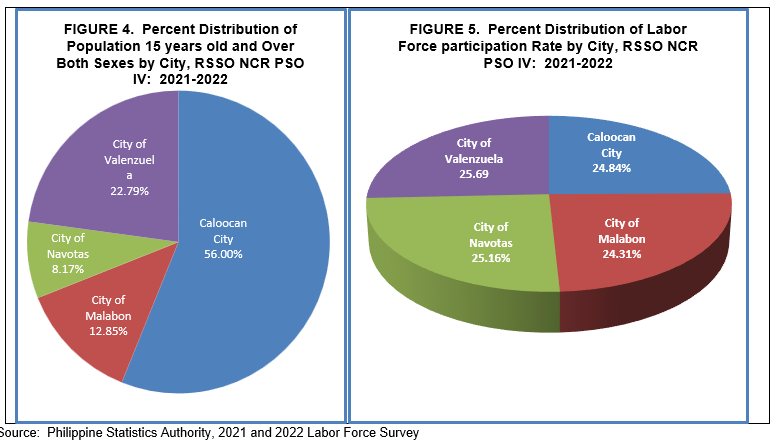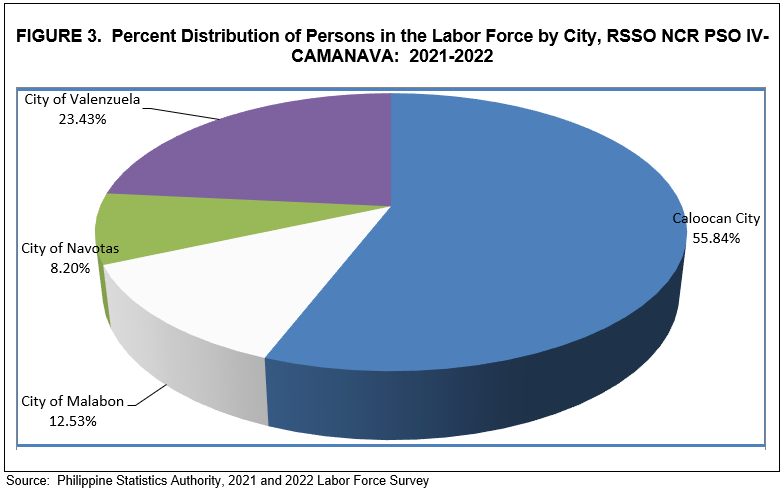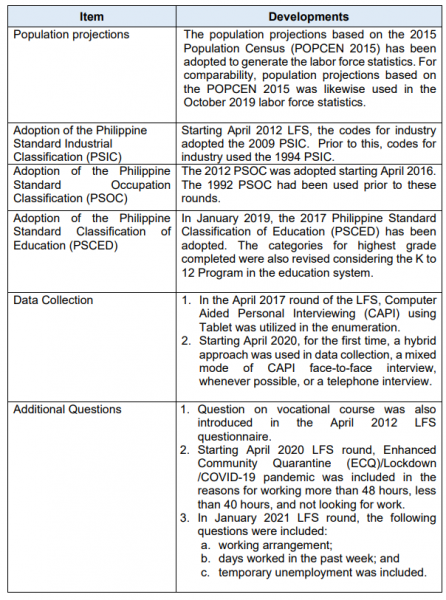This special release presents data on Population 15 years old and over, Total Persons in the Labor Force, and Labor Force Participation Rate: 2021 and 2022 in Regional Statistical Service Office National Capital Region Provincial Statistical Office IV (RSSO NCR PSO IV (Caloocan, Malabon, Navotas and Valenzuela) from 2021-2022. Region, Province and City/Municipality, Philippines base figures on the results from the Number of 2021 and 2022 Labor Force Survey.
The total number of persons on the labor force, in the RSSO NCR PSO IV (CAMANAVA) during the period of 2022 was 49,562 this number represents an increase of 3.90 percent compared with the 47,703 in the same period of 2021.
Across the country, RSSO NCR PSO IV (CAMANAVA) contributed 2.61 percent to the total number of persons in the labor force, and 20.25 percent to the total number in the Regional Statistical Service Office National Capital Region (RSSO NCR) during the period of 2022.
Table 1. Population 15 years old and over, Total Persons in the Labor Force, and Labor Force Participation Rate: 2021 and 2022
REGION, PROVINCE, CITY | Population 15 years old and over, Total Persons in the Labor Force, and Labor Force Participation Rate: 2021 and 2022 | |||||
| 2022 | 2021 | |||||
| Population 15 years old and over Both Sexes | Total Persons in the Labor Force | Labor Force Participation Rate | Population 15 years old and over Both Sexes | Total Persons in the Labor Force | Labor Force Participation Rate | |
(1) | (2) | (3) | (4) | (5) | (6) | (7) |
| PHILIPPINES* | 76,599 | 49,562 | 64.7 | 75,301 | 47,703 | 63.4 |
| RSSO NCR | 10,107 | 6,385 | 62.5 | 10,107 | 6,149 | 60.8 |
| RSSO NCR PSO IV | 2,093 | 1,293 | 246.8 | 2,087 | 1241 | 239.3 |
| Caloocan City | 1,176 | 722 | 61.3 | 1,172 | 694 | 59.2 |
| City of Malabon | 269 | 162 | 60.0 | 269 | 157 | 58.4 |
| City of Navotas | 171 | 106 | 62.1 | 172 | 107 | 62.0 |
| City of Valenzuela | 477 | 303 | 63.4 | 474 | 283 | 59.7 |
Source: Philippine Statistics Authority, 2021 and 2022 Labor Force Survey
About 25 persons weekly average in the labor force
During the period of 2022, on the average, 25 persons were in the labor force weekly, or monthly/quarterly average of about four 42 and 91 persons in the labor force respectively at NCR PSO IV (CAMANAVA). (Table1)

Number of Persons in the Labor Force Increases
The Number of persons in the labor force during the period of 2021 to 2022 in the City of Caloocan had the most occurrence at 722 persons an increased by 4.03 percent from 694 persons recorded during the same period in 2021 followed by the City of Valenzuela with 303 persons went up by 7.07 percent from 283 in the same period of 2021, and an increase of 1.52 percent of combined data in the cities of Malabon and Navotas to 268 persons from 264 persons during the period of 2021.

City of Caloocan contributed the highest number of persons in the labor force among the cities in the Regional Statistical Service Office National Capital Region Provincial Statistical Office IV
The City of Caloocan dominated all other cities of persons in the labor force with 722 or 55.84%, City of Valenzuela to 303 or 23.43% and in the cities of Malabon and Navotas with 268 or 20.73% respectively.
Figure 3-5. Shows the percentage distribution of persons in the labor force, Population 15 years old and over both sexes, Labor Force Participation Rate by city in the Regional Statistical Service Office National Capital Region Provincial Statistical Office IV (RSSO NCR PSO IV-CAMANAVA) 2021- 2022


Explanatory Notes
Data on 2021-2022 Provincial Labor Market presented in this release were obtained from the results of gathered data on the demographic and socioeconomic characteristics of population conducted quarterly and monthly by interviewing sample households all throughout the country. Information presented includes Population 15 years old and over, Total Persons in the Labor Force, and Labor Force Participation Rate which occurred from 2021 and 2022.
I. Introduction
a. Background
The stability and growth of a country's economy hinges on its ability to produce goods and services for both domestic and international use. labor represents an important factor of production, hence, the improvement of the quality of the labor force, and efforts to make it more productive and responsive to growth are necessary for the development of the economy. A clear knowledge and understanding of the size, composition, and other characteristics of the segment of the population is a big step in this direction. A continuing supply of the data on labor force is indispensable to national and local development planning.
The labor force Survey (LFS) is a vehicle to gather such data on the demographic and socioeconomic characteristics of the population with nationwide coverage and conducted on a quarterly and monthly mode by interviewing households. The Philippine Statistics Authority (PSA) implements the LFS.
b. Objectives
The LFS aims to provide a quantitative framework for the preparation of plans, and formulation of policies affecting the labor market.
Specifically, the survey is designed to provide statistics on levels and trends of employment, unemployment, and underemployment for the country, as a whole, and for each of the regions.
c. Scope and Coverage
With national level as domain, survey operations for Monthly and quarterly LFS of each month covered one replicate and four replicate respectively.
Overseas Filipino Workers are not considered part of the labor force in the Philippines. Hence, in the LFS, data on economic characteristics of household members who are overseas workers are not collected. In the LFS report, they are excluded in the estimation of the size of working population, i.e., population aged 15 years and older, and in the estimation of the labor force.
d. Development in the LFS
The LFS, as in any survey, adopts recent developments in statistical methodology/processes and in the education system. The revisions in the LFS are as follows:
II. Concepts and Definitions
a. Reference Period
The reference period for each survey is the "past week" referring to the past seven (7) days preceding the date of visit of the enumerator or the interviewer.
b. Employment Status
1. Population 15 Years Old and Over
This refers to number of population 15 years old and over excluding overseas workers. Overseas workers are excluded in the estimation of the size of working population (population aged 15 years and over) since the data on their economic characteristics are not collected because they are not considered part of the labor force in the country.
2. In the Labor Force or Economically Active Population
This refers to persons 15 years old and over who are either employed or unemployed in accordance with the definitions described below.
3. Employed
Employed persons include all those who, during the reference period are 15 years old and over as of their last birthday, and are reported either:
a. At work, i.e., those who do any work even for one hour during the reference period for pay or profit, or work without pay on the farm or business enterprise operated by a member of the same household related by blood, marriage, or adoption; or
b. With a job but not at work, i.e., those who have a job or business but are not at work because of temporary illness or injury, vacation, or other reasons. Likewise, persons who expect to report for work or to start operation of a farm or business enterprise within two weeks from the date of the enumerator’s visit are considered employed.
4. Underemployed
Underemployed persons include all employed persons who express the desire to have additional hours of work in their present job, or an additional job, or to have a new job with longer working hours. Visibly underemployed persons are those who work for less than 40 hours during the reference period and want additional hours of work.
5. Unemployed
Starting April 2005, the new unemployment definition was adopted per NSCB Resolution Number 15 dated October 20, 2004. As indicated in the said resolution:
Unemployed persons include all those who, during the reference period, are 15 years old and over as of their last birthday, and reported as persons:
a) Without work, i.e., had no job or business during the reference period; were available and willing to take up work in paid employment during the reference period or self-employment during the reference period, and/or would be available and willing to take up work in paid employment or self-employment within two weeks after interview date; and
b) Currently available for work, i.e., were available and willing to take up work in paid employment or self-employment during the reference period, and/or would be available and willing to take up work in paid employment or self-employment within two weeks after the interview date; and
c) Seeking work, i.e., had taken specific steps to look for a job or establish a business during the reference period, or
Not seeking work due to the following reasons: (1) fatigued or believed no work available, i.e., discouraged workers; (2) awaiting results of previous job application; (3) temporary illness or disability; (4) bad weather; and/or (5) waiting for rehire or job recall.
6. Persons Not in the Labor Force
Persons 15 years old and over who are neither employed nor unemployed according to the definitions mentioned. Those not in the labor force are persons who are not looking for work because of reasons such as housekeeping, schooling, and permanent disability. Examples are housewives, students, persons with disability, or retired persons.
BELEN R. RAZO
Chief Statistical Specialist
PSA RSSO NCR PSO IV-(CAMANAVA)
